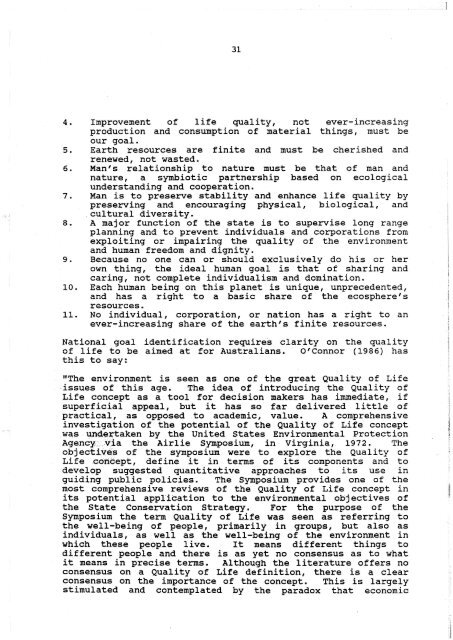soil-conservation-people-religion-and-land.pdf - South West NRM
soil-conservation-people-religion-and-land.pdf - South West NRM
soil-conservation-people-religion-and-land.pdf - South West NRM
Create successful ePaper yourself
Turn your PDF publications into a flip-book with our unique Google optimized e-Paper software.
Improvement of life quality, not ever-increasing<br />
production <strong>and</strong> consumption of material things, must be<br />
our goal.<br />
Earth resources are finite <strong>and</strong> must be cherished <strong>and</strong><br />
renewed, not wasted.<br />
Man's relationship to nature must be that of man <strong>and</strong><br />
nature, a symbiotic partnership based on ecological<br />
underst<strong>and</strong>ing <strong>and</strong> cooperation.<br />
Man is to preserve stability <strong>and</strong> enhance life quality by<br />
preserving <strong>and</strong> encouraging physical, biological, <strong>and</strong><br />
cultural diversity.<br />
A major function of the state is to supervise long range<br />
planning <strong>and</strong> to prevent individuals <strong>and</strong> corporations from<br />
exploiting or impairing the quality of the environment<br />
<strong>and</strong> human freedom <strong>and</strong> dignity.<br />
Because no one can or should exclusively do his or her<br />
own thing, the ideal human goal is that of sharing <strong>and</strong><br />
caring, not complete individualism <strong>and</strong> domination.<br />
Each human being on this planet is unique, unprecedented,<br />
<strong>and</strong> has a right to a basic share of the ecosphere's<br />
resources.<br />
No individual, corporation, or nation has a right to an<br />
ever-increasing share of the earth's finite resources.<br />
National goal identification requires clarity on the quality<br />
of life to be aimed at for Australians. O'Connor (1986) has<br />
this to say:<br />
"The environment is seen as one of the great Quality of ~ife<br />
issues of this age. The idea of introducing the Quality of<br />
Life concept as a tool for decision makers has immediate, if<br />
superficial appeal, but it has so far delivered little of<br />
practical, as opposed to academic, value. A comprehensive<br />
investigation of the potential of the Quality of Life concept<br />
was undertaken by the United States Environmental Protection<br />
Agency: via the Airlie Symposium, in Virginia, 1972. The<br />
objectives of the symposium were to explore the Quality of<br />
Life concept, define it in terms of its components <strong>and</strong> to<br />
develop suggested quantitative approaches to its use in<br />
guiding public policies. The Symposium provides one of the<br />
most comprehensive reviews of the Quality of Life concept in<br />
its potential application to the environmental objectives of<br />
the State Conservation Strategy. For the purpose of the<br />
Symposium the term Quality of Life was seen as referring to<br />
the well-being of <strong>people</strong>, primarily in groups, but also as<br />
individuals, as well as the well-being of the environment in<br />
which these <strong>people</strong> live. It means different things to<br />
different <strong>people</strong> <strong>and</strong> there is as yet no consensus as to what<br />
it means in precise terms. Although the literature offers no<br />
consensus on a Quality of Life definition, there is a clear<br />
consensus on the importance of the concept. This is largely<br />
stimulated <strong>and</strong> contemplated by the paradox that economic
















